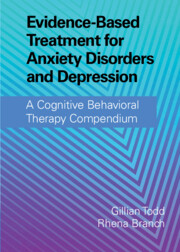 Evidence-Based Treatment for Anxiety Disorders and Depression
Evidence-Based Treatment for Anxiety Disorders and Depression from Part One - Cognitive Behavioral Therapy for Anxiety Disorders
Published online by Cambridge University Press: 06 January 2022
Agoraphobia is characterized by the avoidance of places such as shopping centers, bridges, tunnels, and crowds due to fear of experiencing intense and often debilitating anxiety symptoms and is commonly diagnosed in young to middle-aged adults and women. When entrenched, agoraphobia imposes severe restrictions on the person’s capacity to venture out of the home. Evidence supports the use of CBT in treating the disorder. Key elements of intervention include psychoeducation, cognitive restructuring, breathing retraining to curtail panic symptoms, strategies to reduce general physical symptoms of anxiety, exposure to interoceptive anxiety-provoking stimuli, and, crucially, gradual in vivo exposure to overcome avoidance. Medications, particularly the SSRI class of drugs, may add to the effects of CBT in some patients. Sole treatment with SSRIs may be necessary where patients are unable or unwilling to pursue CBT. Treatment outcomes are more favorable when a management plan is developed collaboratively with a motivated patient and with partners and family involved in treatment. Booster CBT sessions may improve treatment outcomes. Recent developments include online programs, apps, and virtual reality platforms to facilitate exposure to anxiety-provoking situations within a CBT framework. Alternative forms of psychotherapy should be considered if CBT has little impact.
To save this book to your Kindle, first ensure [email protected] is added to your Approved Personal Document E-mail List under your Personal Document Settings on the Manage Your Content and Devices page of your Amazon account. Then enter the ‘name’ part of your Kindle email address below. Find out more about saving to your Kindle.
Note you can select to save to either the @free.kindle.com or @kindle.com variations. ‘@free.kindle.com’ emails are free but can only be saved to your device when it is connected to wi-fi. ‘@kindle.com’ emails can be delivered even when you are not connected to wi-fi, but note that service fees apply.
Find out more about the Kindle Personal Document Service.
To save content items to your account, please confirm that you agree to abide by our usage policies. If this is the first time you use this feature, you will be asked to authorise Cambridge Core to connect with your account. Find out more about saving content to Dropbox.
To save content items to your account, please confirm that you agree to abide by our usage policies. If this is the first time you use this feature, you will be asked to authorise Cambridge Core to connect with your account. Find out more about saving content to Google Drive.